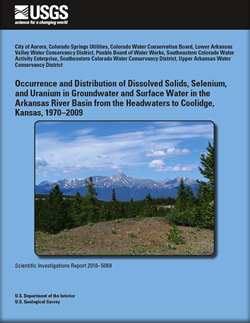Scientific Investigations Report 2010–5069
Abstract
In 2007, the U.S. Geological Survey (USGS), in cooperation with City of Aurora, Colorado Springs Utilities, Colorado Water Conservation Board, Lower Arkansas Valley Water Conservancy District, Pueblo Board of Water Works, Southeastern Colorado Water Activity Enterprise, Southeastern Colorado Water Conservancy District, and Upper Arkansas Water Conservancy District began a retrospective evaluation to characterize the occurrence and distribution of dissolved-solids (DS), selenium, and uranium concentrations in groundwater and surface water in the Arkansas River Basin based on available water-quality data collected by several agencies. This report summarizes and characterizes available DS, dissolved-selenium, and dissolved-uranium concentrations in groundwater and surface water for 1970–2009 and describes DS, dissolved-selenium, and dissolved-uranium loads in surface water along the main-stem Arkansas River and selected tributary and diversion sites from the headwaters near Leadville, Colorado, to the USGS 07137500 Arkansas River near Coolidge, Kansas (Ark Coolidge), streamgage, a drainage area of 25,410 square miles. Dissolved-solids concentrations varied spatially in groundwater and surface water in the Arkansas River Basin. Dissolved-solids concentrations in groundwater from Quaternary alluvial, glacial drift, and wind-laid deposits (HSU 1) increased downgradient with median values of about 220 mg/L in the Upper Arkansas subbasin (Arkansas River Basin from the headwaters to Pueblo Reservoir) to about 3,400 mg/L in the Lower Arkansas subbasin (Arkansas River Basin from John Martin Reservoir to Ark Coolidge). Dissolved-solids concentrations in the Arkansas River also increased substantially in the downstream direction between the USGS 07086000 Arkansas River at Granite, Colorado (Ark Granite), and Ark Coolidge streamgages. Based on periodic data collected from 1976–2007, median DS concentrations in the Arkansas River ranged from about 64 mg/L at Ark Granite to about 4,060 mg/L at Ark Coolidge representing over a 6,000 percent increase in median DS concentrations. Temporal variations in specific conductance values (which are directly related to DS concentrations) and seasonal variations in DS concentrations and loads were investigated at selected sites in the Arkansas River from Ark Granite to Ark Coolidge. Analyses indicated that, for the most part, specific conductance values (surrogate for DS concentrations) have remained relatively constant or have decreased in the Arkansas River since about 1970. Dissolved-solids concentrations in the Arkansas River were higher during the nonirrigation season (November–February) than during the irrigation season (March–October). Average annual DS loads, however, were higher during the irrigation season than during the nonirrigation season. Average annual DS loads during the irrigation season were at least two times and as much as 23 times higher than average annual DS loads during the nonirrigation season with the largest differences occurring at sites located downstream from the two main-stem reservoirs at USGS 07099400 Arkansas River above Pueblo, Colorado (Ark Pueblo), (which is below Pueblo Reservoir) and USGS 07130500 Arkansas River below John Martin Reservoir, Colorado (Ark below JMR). View report for unabridged abstract. |
First posted July 20, 2010 For additional information contact: Part or all of this report is presented in Portable Document Format (PDF); the latest version of Adobe Reader or similar software is required to view it. Download the latest version of Adobe Reader, free of charge. |
Miller, L.D., Watts, K.R., Ortiz, R.F., and Ivahnenko, Tamara, 2010, Occurrence and distribution of dissolved solids, selenium, and uranium in groundwater and surface water in the Arkansas River Basin from the headwaters to Coolidge, Kansas, 1970–2009: U.S. Geological Survey Scientific Investigations Report 2010–5069, 59 p.
Abstract
Introduction
Methods of Investigation
Occurrence and Distribution of Dissolved Solids, Selenium, and Uranium in Groundwater and Surface Water in the Arkansas River Basin from the Headwaters to Coolidge, Kansas
Comparison of Dissolved Solids, Selenium, and Uranium Concentrations in Groundwater and Surface Water
Summary
Acknowledgments
Selected References
Appendix 1: Sources of Groundwater and Surface-Water Data Used in the Report
Appendix 2: Temporal Variations in Instantaneous Specific-Conductance Values and Streamflow at Selected Surface-Water Sites in the Arkansas River Basin, Colorado, 1960–2009